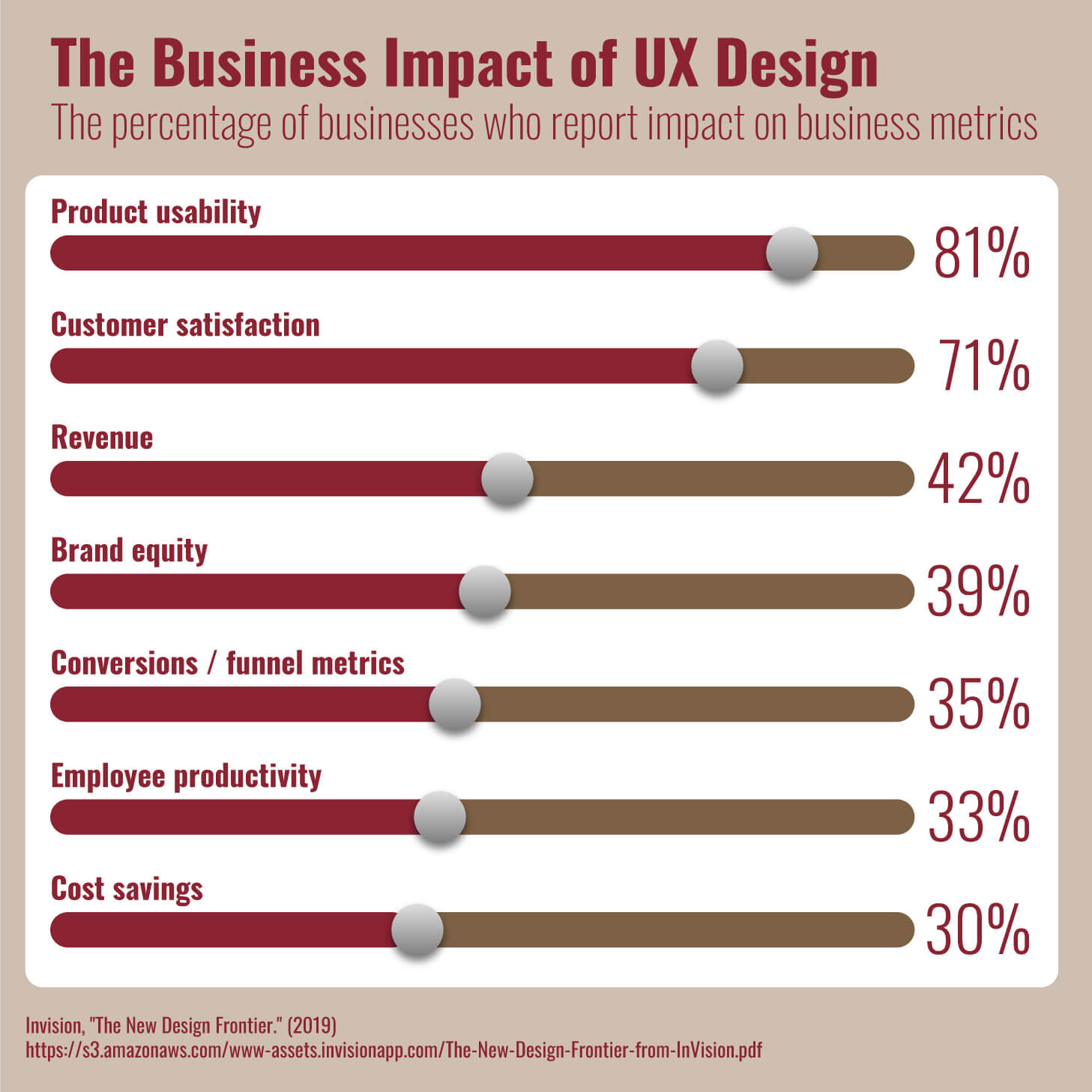Career Paths for UX Designers: Your Best Options

Aesthetics and usability have always appealed to you. You have a knack for pinpointing the features that make your friends trash a new purchase in frustration; you shake your head at clashing color combinations that you just know will overshadow a product’s superb functionality.
You are, at heart, a UX designer. But how can you apply your natural talents and industry interest? What does a UX designer career path look like — and what will you need to do to navigate it successfully?
In this article, we’ll touch on the profession and all the qualifications you’ll need to land a job. Then, we’ll plot out what you can expect from entry-, mid-level, and senior roles — and highlight a few side paths that aren’t on the typical corporate thoroughfare.
Let’s get started!
What is a UX Designer?
User experience, commonly dubbed UX, refers to the process of ensuring that a product’s design offers meaningful, convenient, and useful experiences to consumers. UX covers the entire process of product management and marketing; this broad term is woven into every part of product creation, encompassing product ideation, prototyping, branding, design, and usability.
But what does a UX designer do on a daily basis? The answer depends heavily on the company and the work environment. However, there are a few industry-wide responsibilities inherent to the profession, including:
- Researching to determine end-user behavior, goals, needs, and motivations
- Creating prototypes and wireframes that define the backbone of the product
- Gathering verbal and non-verbal feedback from end-users during the product testing phase
- Collaborating with departments and company stakeholders to craft a usable, impactful product
According to the 2019 InVision Report on The New Design Frontier, 81 percent of surveyed business respondents stated that their design team had a proven positive impact on product utility, while 71 percent claimed that good design boosts customer satisfaction. An additional 42 percent reported that UX improves revenue, and 30 percent stated that it led to cost savings.

As one researcher for the InVision report concluded on the matter, “Companies in our study reported that when design takes center stage, it can have a direct impact on tangible business results, like revenue, valuation, and time to market.”
Ultimately, businesses’ interest in the benefits of UX has made UX design an excellent career choice. Onward Search’s list for the 19 Most In-Demand Digital Creative Talent for 2019 positioned UX designers as the second-most in-demand professionals for that year.
There’s little doubt that the UX design career path will remain well-trafficked, either. Researchers for DICE Insights projected that job growth for UX/UI professionals would climb 14.9 percent over the next ten years.
So, what chops do you need to successfully navigate a UX designer career progression? Below, we’ll discuss a few of the core skills that every UX professional needs to succeed.
What Skills Does a UX Designer Need?
Before you start along the UX designer career path, it’s important to learn the tools of the trade. While specific responsibilities vary significantly depending on the role, UX professionals must share the same core set of skills to meet employer expectations.
Let’s jump into a short walk-through of the most important analytical and technical capabilities you’ll need.
Qualitative and Quantitative Research
Qualitative research requires the collection and observation of non-numerical data. Opinions, motivations, needs, and even fears function as qualitative data. Quantitative analysis, on the other hand, refers to the gathering of numerical, measurable data. Traditional web analytics tools, such as Google Analytics (GA) and user surveys, are used to gather relevant quantitative data.
While quantitative data can tell you that something happened, it won’t tell you why. Without qualitative data, you risk assuming your users’ intentions and needs, which leads to the scourge of UX design: the “Narrative Fallacy.”
If one portion of your site has a high bounce rate — meaning that clients exit the page without interacting — you might assume that the early departure is the result of a poor design choice. However, it could be due to several other factors, such as a faulty tracking capability or even the right information being presented at the wrong time.
In short, collecting qualitative and quantitative data is a crucial prerequisite to understanding user needs and experiences.
User Need Identification
If users’ needs aren’t addressed, a company risks losing its market share. In fact, a product that doesn’t neatly identify and address user needs will hardly be marketable at all.
UX designers help bridge the gap between cloistered product development teams and end-users. By successfully identifying needs and accommodating them with helpful changes, UX designers can improve a product at every stage of its lifecycle — from brainstorming to final launch.
Persona Creation
User personas are fictional characters based on current or targeted customer groups. These constructed profiles help to answer basic questions, such as:
- Who is our target audience?
- What’s their main goal?
- What prevents them from achieving their goal?
UX designers create user personas early in the development of a product. The use of demographic and psychosocial data allows companies to optimize the way that they market their products.
InVision
InVision is an application that allows UX designers to create robust, richly interactive prototypes. The software lets designers iterate prototypes quickly, evaluate their quality, and create a minimum viable product in as little time as possible. Designers can even collaborate on the same product for a more seamless workflow.
Decision Mapping
Decision mapping helps designers gain clarity on the problem they are attempting to solve. The technique helps to explain why research is being conducted and uses gathered data to inform strategic decision making.
Common decision-mapping questions may include:
- Should we build this product?
- Can we remove this feature without negative repercussions?
- Do we need to streamline the customer conversion process?
Color Theory
Those on the UX designer career path aren’t just interested in crafting functional products; they want to make a product shine. In this pursuit, understanding color theory and clients’ psychological reactions to color palettes is key.
A product’s associated color palette plays a big part in end-users’ initial impressions; deep blues, for example, can encourage feelings of loyalty, bright reds and oranges can simulate desire or excitement. Having a thorough understanding of color theory and its importance in UX and UI is essential.
HTML/CSS
HTML and CSS are two critical components in user-interface creation. HTML, or HyperText Markup Language, defines the structure of a web page, while CSS (Cascading Style Sheets) alters the appearance of these foundational elements.
Knowing these languages can make it much easier for UX designers to communicate effectively with the web development team and preemptively solve basic concerns that the development team might bring up.
How Can I Learn Them?
Contrary to what you might think, there’s not one “right” path to acquiring the knowledge you need to thrive during your UX designer career progression. Instead, the route you take depends on your situation, preferences, and resources.
Before choosing a path, consider these key questions:
- What’s my desired timeline for upskilling?
- What am I willing to pay for my education?
- Can I commit to a shorter full-time program, or would a longer part-time one work better for my schedule?
- Would I learn better in an in-person class or a virtual one?
- Do I prefer the structure of an instructor-led program or one I define myself?
If you have yet to pursue an undergraduate degree, you should consider a major in design, computer science, or even psychology. The right college experience can land you key industry contacts, internships, and the prerequisite education required for analytical research.
That said, college isn’t for everyone — and that’s okay! Each UX designer career path looks different, and successful designers come from a variety of educational backgrounds.
Many prefer undergoing a short-term and intensive program known as a boot camp. UX boot camps provide you with the full professional toolkit you need within just three to six months, depending on the class schedule. Some boot camp providers offer online, in-person, part-time, and full-time programs to better fit with your schedule and learning style.
If you prefer less structured learning environments, consider taking self-guided online classes or referencing books, free tutorials, and reading how-to articles. Keep in mind that it takes a tremendous amount of discipline and passion to self-teach; we recommend reaching out to UX professionals, attending conferences, and learning with a buddy to keep your motivation up.
After getting your technical skills up to par, an aspiring UX designer such as yourself may wonder: Now what?
Good question — it’s time to start applying to your first position!
Securing an Entry-Level Position
The first stop on the UX designer career path is to land an entry-level job. No matter the industry, it can be hard to break into that very first role; entry-level job applications come with their fair share of sleepless nights, rejection emails, and last-minute interview prep sessions. As a newbie UX professional, you’ll need to put in the time to establish yourself as a talented, high-potential candidate.
First, consider refining your resume by seeking out a UX internship. To prepare, you should have a strong portfolio of work and a well-written resume. Of course, most internships are only available to current students. To land a role with no relevant experience, make sure to highlight self-directed projects on your resume and take at least one certificate-based UX course.
Check out the job description of the roles you’re applying for and craft your resume with those requirements in mind. Think; how has your experience prepared you for the position you are applying for?
Entry-level UX positions may be required to fulfill critical responsibilities. These include but are not limited to:
- Meeting with clients to gather information about their needs and wants
- Sketching out visual concepts on paper and in software applications
- Creating user personas, site maps, and information architecture schemes
- Developing cross-platform solutions for different user interfaces
- Meeting with stakeholders and departments to communicate findings
Becoming a Manager
With a few years of experience under your belt, you’re ready to climb the corporate ladder. Many fresh-faced UX designers eventually find themselves naturally entering management roles within a product development team.
Of course, your ascension will depend on the size of the company and its current needs. UX teams take several different structures: centralized, decentralized, and hybrid.

In a centralized team, all UX designers report to a single UX manager, who defines the team’s goals and works on various products as needed. Decentralized teams, on the other hand, have no core UX manager; instead, individual UX professionals are embedded throughout the organization to align product features with user goals.
Hybrid (or matrix) teams are a mix of both — UX designers report to a central UX manager while also working directly with product teams on distinct products.
To become a manager, you’ll need to toe the thin line between being a good teammate and setting yourself apart. Always take the time to get to know your teammates: try to understand what drives them, what inspires them, and their ultimate career ambitions. Act as an advocate for the whole team by communicating their value to upper management.
UX managers take on several responsibilities, including:
- Leading the UX team on multiple projects while identifying teammates’ core skills and weaknesses
- Communicating goals and growth opportunities with senior management and company stakeholders
- Providing project management support with the product development department
- Specifying the day-to-day duties of UX teammates
- Advocating for the UX designer career progression of stand-out teammates with company higher-ups
Landing a Senior-Level Role
The UX designer career path doesn’t stop suddenly at managerial roles. In many companies, a designated Head of UX works side by side with VPs, playing a pivotal role in defining the company’s direction.
To become the Head of UX, you’ll need to have a storied background in conceptualizing, designing, and curating successful product experiences for end-users. In this highly competitive role, your day-to-day responsibilities may include:
- Building, leading, and growing a UX team to fulfill the company’s goals
- Forging a long-term vision for where a company and its products are headed
- Ensuring annual product revenue and consumer targets are met through rigorous statistical inquiry
- Creating trust and credibility between company stakeholders, departments, and the UX team
Alternative Paths: Transitioning Into Product Management
A UX background equips you with everything you need to know to develop and launch viable products.
As a designer, you focus on, well, the design. However, if you’re more interested in the business side of the equation, product management might be the right role for you. A product manager defines a project’s goals and timeline, and tracks it right through to launch. While user experiences deal directly with the user, product management is focused primarily on how a product is developed.
Like UX designers, project managers offer cross-team leadership and loop in design, development, marketing, sales, and customer support teams as needed.
Alternative Paths: Freelancing
Not interested in climbing the corporate ladder? You’re not alone — many UX designers are drawn to the profession because of its flexibility.
UX freelancing can be empowering. It offers a means to make your mark on the UX industry and create impactful experiences without waiting on a company’s permission.
Ultimately, freelancing is ideal for those who are naturally self-directed and confident enough to move between disciplines. On some projects, you may be a user researcher, while others might require more strategic or architectural support.
Of course, freelancing may come with anxiety. Who knows when you’ll be dropped from a team or when you’ll land your next big project. It’s up to you: Would you feel less anxious in a company setting, or do you enjoy the challenge of reaching out to new clients by yourself?
Final Thoughts
So, where are you on your UX career path? Will you take the initiative to enroll in an educational program and upskill — or are you ready to take on your first job in the industry?
Gaining a background in UX design can be a terrific decision. After all, what company wouldn’t want an employee who can effectively identify and address consumer needs? Foraying into UX can help you build the foundation for a rewarding and exciting career.

 Live Chat
Live Chat